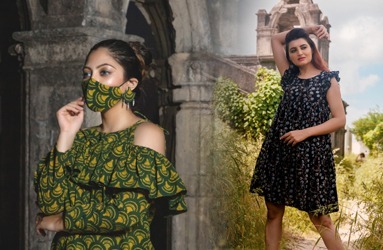
Ajrakh cloth carries many meanings. The popular story amongst local printers is that Ajrakh means “keep it today.” It is also linked to azrakh, the Arabic word for indigo, a blue plant which thrived in the arid ecology of Kachchh until the 1956 earthquake.
Ajrak is a block-printed textile that is resist-dyed using natural dyes. Including indigo and madder. It is made in Kutch, Gujarat and is distinguished by its color- blue with red — and its complex geometric & floral patterns. Its name is derived from ‘azarak’, ‘blue’ in Arabic & Persian. Ajrak is a legacy of text. It takes skill & patience to make Ajrak. There are between 14–16 different stages of dyeing & printing, which take 14–21 days to complete. The resulting cloth is soft against the skin and jewel-like in appearance, pleasing to touch & appealing to the eye.
- Artifacts related to Ajrakh have been found in the excavated remains from the Indus valley civilizations- Harappa and Mohenjo-Daro. Cloth artifacts with similar dyeing techniques have also been found in the Al-Fostat excava tions in the Nile delta near Cairo, Egypt.
- Ajrak is said to signify the Universe. Because of the use of color palate. Color red for earth, black for darkness, white for clouds and blue for Universe itself. Think moonless, think midnight, and think darkness… the star spangled sky, against a stark blue-black background. This is what ajrakh (aka ajrak), meaning blue in Arabic, is likened to.
- Nature plays an important role in the making of Ajrak. The craftsmen work in total harmony with their environment, where the sun, river, animals, trees and mud are all part of its making.
When the world is buzzing with “sustainability” and “environment-friendly” as the newest big trends of the future, for many centuries, innumerable crafts have existed in harmony with nature. Some things so subtle that they do not glare out, yet so vivid that one cannot help but appreciate the aesthetics in their creation. One such craft is the Ajrak.
Traditionally, Ajrak is the name of a block printed cloth with deep crimson red and indigo blue background, bearing symmetrical patterns with interspersed unprinted sparkling white motifs. An ancient craft, the history of the Ajrak can be traced back to the civilizations of the Indus Valley that existed around 2500 BC-1500 BC.
The term “Ajrak”, may be derived from “Azrak”, meaning blue in Arabic, as blue happens to be the one of the principal colours in Ajrak printing. More than a fabric, Ajrak is a Sindhi tradition; found in daily usage such as hammocks and bedsheets to duppattas, scarves, and even gifts as a token of respect. The highly valued Ajrak has also been made in Kutchfor the Maldharis or cattle herders’ communities since the time Khatris migrated from Sindh in the 16th century. The Khatri community, whose name means “one who fills or changes colours,” printed cloth with the locally available natural dyes and water from the Dhamadka, the river that gave their village its name. Today the ajrak traditions are maintained in Kutch, and in Khavda, Dhamadka and Barmer in Rajasthan.
It is the synergy between handloom textiles and vegetable dyes that creates magic. The introduction of chemical dyes led to the decline of natural dyes towards the end of the nineteenth century. Ajrakh printing, using natural dyes is one of the oldest techniques of resist printing in India and is one of the most complex and sophisticated methods of printing.
Ajrakh printed cotton is traditionally worn by the pastoral Maldhari community. Apart from pagdis and lungis the women wear printed skirts, and use the ajrakh fabric as bed covers to line cradles for babies. Every colour tells a story and the design images the status. The Khatris have developed a feel for the contemporary market and now ajrakh yardage, kurta sets, furnishings, scarves can be bought.
A remarkable feature of ajrakh printing is that on a single fabric, using the same design, resist printing is combined with other printing and dyeing techniques. The whole process is repeated on both sides of the fabric in perfect cohesion, which calls for unsurpassed skill. Ajrakh uses mud-resist in the various stages and another unique feature is that the dyeing and printing is repeated twice on the fabric to ensure brilliance of colour. Superimposing the repeats is done so perfectly that the clarity is sharpened.
To identify ajrakh one needs to look for fabric with a background of red or blue (though other vegetable dye colours like yellow and green have been introduced) Traditionally four colours were used red (alizarin), blue (indigo), black (iron acetate) white (resist). The ajrakh makers believe that the printed fabric has warm and cool colours which steady the body temperature… blue is cooling and red is warm.
.png)